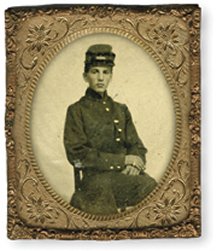Combat Trauma from the Past: Data portray Civil War’s mental, physical fallout
Thanks to extensive military and medical records for Union Army veterans of the U.S. Civil War, a research team has determined that soldiers who saw many of their comrades killed or who were prisoners of war experienced a greater incidence of serious physical and mental ailments later in life and died at younger ages than other veterans did.

The link between harrowing combat experiences and various postwar illnesses and death was strongest among younger groups of soldiers, reaching a peak in those who had enlisted between ages 9 and 17, say Judith Pizarro of the University of California, Irvine and her colleagues.
“Many psychological symptoms of Civil War veterans look a whole lot like post-traumatic stress disorder (PTSD), but we couldn’t assign that diagnosis to individuals based on this data,” says Irvine psychologist and coauthor Roxane Cohen Silver.
The new findings appear in the February Archives of General Psychiatry.
The psychologically tumultuous postwar lives of Civil War combat veterans strikingly resemble the lives of Vietnam combat veterans, who have high rates of mental disorders, remarks psychiatrist Roger K. Pitman of Massachusetts General Hospital in Charlestown.
PTSD typically includes intrusive thoughts or dreams about a life-threatening event, avoidance of reminders of the event, social withdrawal, and a sense of being on constant alert for danger.
To study combat’s lasting effects on those who survived the Civil War, Pizarro’s team analyzed a previously assembled computerized database. It includes medical records and reports of physical examinations of Civil War veterans conducted during their postwar lifetimes. For 15,027 randomly selected recruits, these records were matched to military records in the same database. Ages at enlistment ranged from 9 to 71. All veterans in the study survived until at least 1890.
War trauma, indicated by heavy casualties in a soldier’s company or having been a prisoner of war, moderately increased veterans’ chances of developing gastrointestinal, cardiac, or mental ailments, the researchers say. The same experiences greatly increased the chance of developing a combination of mental and physical illnesses.
Civil War veterans who had been wounded exhibited a high rate of psychological problems but relatively little physical disease, perhaps because only particularly hardy individuals survived battlefield injuries, Silver suggests.
Pitman “strongly suspects” that PTSD afflicted many Civil War veterans. One piece of evidence is the heightened risk of psychiatric problems among the youngest soldiers. Recent research finds that brain areas that regulate emotion and deal with the aftermath of trauma don’t mature until young adulthood, Pitman says.
The Civil War undoubtedly devastated the lives of surviving soldiers, says historian and attorney Eric T. Dean Jr. of New Haven, Conn. “But it’s hard to make fine-grained conclusions, such as those in this new study, based on primitive medical notes and observations from the 19th century,” says Dean, who previously examined psychological records of Civil War veterans from Indiana.
More Civil War soldiers died from disease that spread through crowded camps than from battle wounds, he adds. Heavy casualties in a company thus might predominantly reflect disease, not fighting, as Pizarro’s team had assumed.